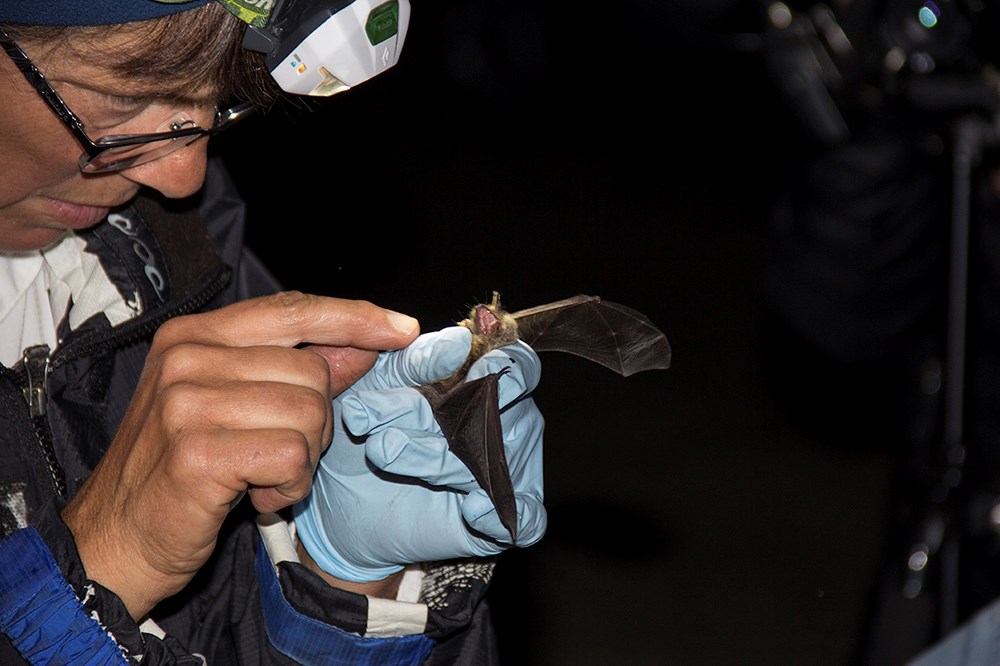Last updated: October 14, 2024
Article
Bats Resource Brief
Background Information

NPS/Melissa Sladek
Threats
The greatest threat to Glacier’s bats is white-nose syndrome (WNS). The disease is spreading since being discovered in New York in 2006, but it has not yet been documented in Montana or Alberta. Since 2018, it has been found in Manitoba, North Dakota, Washington, and Wyoming. WNS is identifiable by a white fungus (Pseudogymnoascus destructans) found growing on the nose and wing membranes of affected bats. The fungus seems to disrupt the body’s homeostasis, leaving bats susceptible to dehydration, electrolyte depletion, and pH imbalance. With a nearly 100% mortality rate in some bat species, an estimated seven million bats have died from WNS since 2006. The disease is now found in 33 states and 7 Canadian provinces. Wind farms along migration corridors are another concern for migratory bats. Local and national research is looking into the causes of wind farm mortality and potential solutions.
Gazing upwards at dusk, visitors may catch a glimpse of one of the most misunderstood and least studied mammals in Glacier and Waterton Lakes National Parks. There are over 1,300 documented species of bats worldwide, which constitutes approximately 25% of all mammal species both in numbers and biomass. Although there are nine documented species of bats found in Glacier and seven in Waterton, little is known about their overall status in these parks.
All of the bats in Waterton and Glacier are effective insectivores. A single little brown bat (Myotis lucifugus) may consume 4 to 8 grams of insects per night, or roughly 50% of their body weight. Contrary to common myth, bats are not blind and in fact do have good eyesight. However, the majority of bat species do not rely on their eyesight to hunt at night. Instead, they depend on echolocation, or locating objects by reflected sound, to find food. Most of the bat species in Glacier and Waterton hibernate through winter in local roosts. However, three species—the hoary bat (Lasiurus cinereus), silver-haired bat (Lasionycteris noctivagans), and eastern red bat (Lasiurus borealis)—are migratory and fly south for the winter. Bats are long-lived but slow-reproducing mammals. Many species have an average lifespan of more than twenty years, giving birth to only one pup each year.
Although commonly associated with the transmission of rabies, less than 1% of the general bat population contracts the disease. Like all mammals, bats can contract rabies, but they do not naturally carry the virus.
Status and Trends
Up until recently, very little information existed about which species of bats are present in Waterton and Glacier, what their population sizes are, and how they utilize the landscape. Surveys begun in 2011 confirmed the presence of three previously undocumented bats in Glacier—California myotis (Myotis californicus), Yuma myotis (Myotis yumanensis), and the eastern red bat (Lasiurus borealis). Of the nine species of bats found in the park, three are now Species of Concern in the state of Montana and two are Potential Species of Concern.
Park researchers use mist nets and acoustic surveys in Glacier and Waterton Lakes National Parks to gather inventories of bats. Acoustic detectors can determine presence as well as indicate specific species by distinguishing between the bats’ unique vocalizations.
The surveys have also confirmed that bats are using one of Glacier’s caves. Whether they use it as a roost site or a hibernaculum (winter hibernation site) is unknown. Continued monitoring efforts will attempt to locate other potential hibernacula and roosting sites within the park. Temperature and humidity data collected so far indicate at least two caves in the park are suitable for bat hibernation.
So far, all of the bats that have been captured and released in Glacier have appeared healthy. Knowing where the highest concentrations of bats are, as well as where bats hibernate in the park, will help managers to make informed decisions when white-nose syndrome, a fungal disease that has killed millions of bats in North America, arrives in Montana.

NPS
Management Strategy
The main goals of continued bat inventory and monitoring are to identify which species are found in Glacier and Waterton Lakes National Parks, discern the habitats they use, determine their overall abundance, locate potential hibernacula, and monitor individuals for white-nose syndrome.
Starting in 2011, Waterton used acoustic surveys and trapping to inventory bats and establish a bat community baseline for the park. They continue to use acoustic surveys to contribute to the North American Bat Monitoring Program, a continent-wide bat monitoring program aimed at assessing the long-term viability of bat populations.
Resources for More Information
Glacier National Park Staff
- Lisa Bate, Wildlife Biological Science Technician
- John Waller, Wildlife Biologist
Documents and web sites
- Bat Conservation International — http://www.batcon.org
- “Glacier’s Bats: An Adventure in Bat Research” video — https://www.nps.gov/rlc/crown/media.htm
- North American Bat Monitoring Program — https://www.nabatmonitoring.org
- White-Nose Syndrome Response Team — https://www.whitenosesyndrome.org
The Crown of the Continent Research Learning Center
Phone: 406-888-7894; Email: Kylie_caesar@nps.gov
Website: www.nps.gov/rlc/crown
